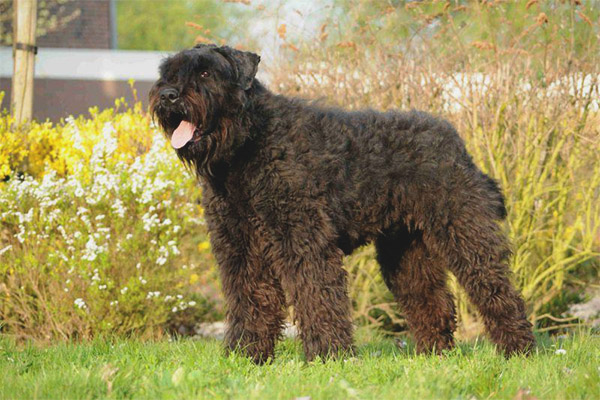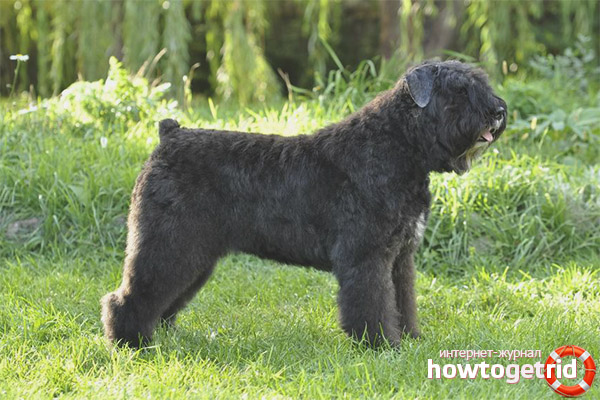The content of the article
The demand of people for this breed has always been invariably strong, but in recent years it has almost doubled. Bouvier of Flanders is a standard breed of herding dogs, which was bred with the sole purpose: to monitor cattle. There is not one name for the breed standard: from the Flemish Pik to the Dutch Koehond. Sometimes these dogs are even called “dirty beard” because of their mustache and beard, which are always soiled in drinking water or food.
History of the occurrence of the bouvier
The name of the breed in translation sounds like a bull dog. It is believed that the place of appearance of these dogs is Flanders, which is currently located on the territory of France and jointly Belgium. If the word bouvier is translated from French, it will mean cow shepherd.The name appeared at a time when such a dog was used by shepherds to observe livestock.
For years, the bouvier was considered to be laborers, working class dogs. The dogs were at the farms, acting as a guard and shepherd. Sometimes you could see them transporting carts full of provisions.
The very first representatives of the breed were very simple, rustic and coarse in a rustic way. Among the ancestors of the dogs were greyhounds of British origin. Later, as a result of selection, the dog with a rather coarse wool appeared to the world. This animal currently serves as the ancestor of the Bouvier of Flanders.
These dogs were considered:
- great hunters;
- amazing watchmen;
- high-class farm assistants and herders.
Up to the beginning of the twentieth century, there is no information on the development of the breed. And just before the war, they began to pay attention to the development of the Bouvier, since the international exhibition of dogs that took place in Brussels had on the list of participants two Bouvier of Flanders, which later became standard samples. Already in 1913, this breed began to enjoy the honor and respect of the French association of dog breeders.
After a couple of decades, the breed standard was adopted, but it was still possible to encounter different opinions about the branches of the Flanders Bouvier. These differences disappeared in the second half of the last century, and in 1965 a new standard was adopted. Currently, in some countries, a great deal of attention is paid to breeding Flanders.
Features of the standard of this breed
At present, these dogs are still referred to herding dogs. The following important proportions and nuances can be noted:
- strong and developed paws;
- The length of the dog’s body is approximately equal to the height of the Bouvier at the withers
- the back is flat, dilated chest;
- powerful limbs;
- the head is heavy, big, there is a mustache and a beard;
- neck is massive, muscular, short;
- the nose is decorated with a small ledge;
- lips pigmented according to color;
- eye fit is correct, the color is close to black shades;
- ears need to stop, stand them upright straight.
Flanders Bouvier has a massive neck, which at a smooth angle is bent to the body. The chest and shoulder blades are wide, the belly is not sunken. The body indicates a secret force, musculature is strong. The tail is cropped, sometimes the breed includes a Bouvier without a tail. Wool hard, very thick, but not long. Sometimes in the black coat of wool there are spots or burns of red color.
Characteristics of the Bouvier
If we talk about character, then the opinion of him is usually positive among many breeders and owners. The dog is very balanced, calm, partly phlegmatic. Often different attachment to one of the family members, but it does not mean that the other pet will not love. It will only be necessary to avoid mistakes in raising this pet, to treat him with love and respect. Then he will be a great guard and pet.
Flanders Bouvier is very calm, rarely they can be seen exhibiting high activity. Those owners who can not harm the dog's psyche and properly carry out the process of training, will receive a real gift in the guise of a dog.
Bouvier is not particularly intrusive, trying not to interfere with family members within the apartment. But in the process of walking or in the ring can show all the necessary traits. For example, one of the most well-known qualities of a Bouvier is his unconditional courage and strong grip. Very responsibly, the dog takes all the responsibilities that lie on his shoulders. The Flanders Bouvier will experience maximum confidence when its owner is nearby. In the character of the dog of this breed there are also notes of perseverance. It will not be possible to force the dog to some act or behavior, if he does not want it.
Bouvier is a very faithful and obedient dog. Very hardworking, curious and good-natured. At the same time, the Flanders Bouvier needs a firm master's hand. But excessive severity should not be. Evolution made a dog stubborn animal, but you can not use force to overcome this trait of character.And it is certainly forbidden to punish the Bouvier, without having a good reason for it. Sometimes a pet may be mischievous or start fooling around when a playful and puppy mood wakes up in it, but the bouvier is not stupid at all.
Food for flanders Bouvier
The bright and well-established character that each member of the breed of Flanders Bouvier possesses determines that the issue of feeding the dog must be approached with particular attention. Only due to the reception of high-quality food the animal will be able to replenish the stock of energy, and this will not result in significant damage to health. Many breeders of these dogs, being in Belgium or in France, hold the general opinion that it is advisable to use dry food. It is necessary to opt for a well-balanced and properly chosen diet so that the dog does not have any further problems with the digestive system.
Until the puppy is half a year old, it is recommended to feed him three times a day, and then for the next six months they offer food twice a day. And only after a year there is a sense to transfer the pet to a single meal.It is advisable not to mix with this feed natural and dry types of feed.
If you want to feed your pet with natural homemade food, then you need to make a diet of lean meat, including poultry, occasionally offering eggs to the dog (approximately every couple of days). You can feed the cereal, and even recommended to use for inclusion in the diet of vegetables. It is best to divide the amount of feed on the morning and evening meals.
It is very important to ensure that the dog does not remain with a dirty beard after eating.
It is unlikely that it will be possible to provide an exact answer on how to correctly feed the dog. It is advisable to smoothly move from one food to another, if the need arises for an abrupt change of diet. If you get a puppy of Flanders Bouvier who took such food from another host that does not suit you, then it is recommended to change the feed very smoothly.
Content puppy and raising dogs
It can be stated with some confidence that the Flanders Bouvier has a late development, but this does not affect the intelligence of the dog, but his temper.Full maturity of an animal ends only by 3 years maximum, and the total duration of their life is about 11 years. Being a puppy, a Bouvier is very attached to the owner, requires long attention from him and always misses the owner. As you grow older it is recommended to change the diet, over time reducing the amount of elements in food.
Males ripen for mating by about two years, and bitches - after the third estrus ends. Usually litter includes about 7-8 puppies, but most often up to six.
Bouvier little exposed to negative factors and various diseases. Nature during the evolution of the dogs took care to ensure that the dogs had tremendous health. They rarely have mental disorders or genetic diseases. The “Achilles heel” of this breed is only the joints.
Usually, with strangers the dog behaves calmly, and with older people or babies, the bouvier behaves benevolently, at any moment being ready to protect them.
- It is very important to engage in the development of the Bouvier’s muscles, walking with him for up to half an hour with each range. If you are fond of jogging or cycling, then the dog will be happy to accompany you.
- Brush and brush your pet's coat.
- It is recommended to trim the beard and dog mustache.
It would be best if the pet will live with the owner in the countryside, outside the city. But it is not recommended to hamper the movement of a Bouvier, using a chain, an aviary or a cage. However, a dog will also be able to live in an urban setting; all he has to do is remember the importance of walking. Also, if the animal is still in puppy age, you will need to regularly take it out to the street, providing the opportunity to stay in the fresh air.
Do not leave your pet alone for too long. And in the remaining moments, just look after the Bouvier of Flanders, and such a dog with joy will turn into a faithful companion for life.
Training Flanders Bouvier
It is worth remembering that the Flemish bouvier can remain cheerful dogs with childishness in the character, despite even old age. They usually do not give voice, being in any room or house, demonstrating a balanced and calm nature.
A dog may perceive strangers with excessive suspicion, but at the same time these animals are very attentive to old people and small children.
Video: breed dog of flander bouvier













To send